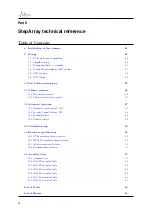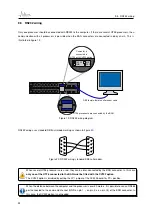
D1
F1
A1
D2
F2
A2
D3
F3
A3
D4
F4
A4
D5
F5
A5
D6
F6
A6
G1
G2
G3
G4
G5
G6
EQ
di
Wave
front
Input
signal
Figure 4: The DGRC principle used by StepArray columns. The wave front is controlled both by the positioning and
orientation of the loudspeakers, and by filters
F
i
, delays
D
i
, and gain
G
i
of each channel.
The main advantages brought by the DGRC principle used in StepArray columns are:
• The column is vertical and can be fitted close to the wall.
• Reduced number of electronic channels, both for DSP and amplifiers. For example, model SA250P which is
2
.
5
m
high uses only 6 channels for 30 loudspeakers. This can make a big cost difference.
• Power is uniformly distributed to all loudspeakers. This way they can all be used at their maximum capabilities,
enhancing overall performance and sound pressure level.
• The number of channels does not depend on the number of loudspeakers. Therefore, many small full-range
loudspeakers can be used to obtain perfect sound quality in the treble range and reduce secondary lobes at
higher frequencies.
2
Overview of the StepArray system
The StepArray range consists of several column models dedicated to speech diffusion and to mid-power music
diffusion in large and/or reverberant enclosed spaces. The different models allow coverage of flat or tilted audience
area ranging from 15m to 68m with perfect speech intelligibility and high sound quality.
Last update: December 23, 2010
9










































